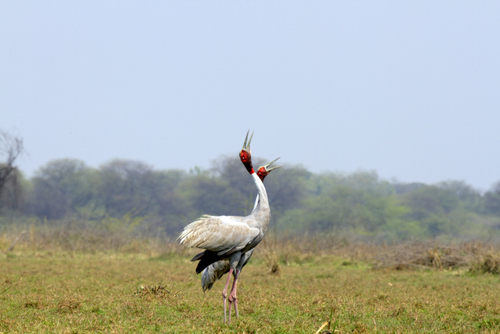WTI Counts 829 Sarus Cranes in Eastern UP
Maharajgunj, May 22, 2015: In an exercise supported by Wildlife Trust of India (WTI), grassroots level Sarus Protection Committees (SPCs) counted sarus cranes (Grus antigone) in Maharajganj district of Eastern Uttar Pradesh. The counting was done by 14 Sarus Protection Committees constituted by WTI at village level around important sarus nesting and congregation grounds. Four volunteers also known as Sarus Mitra coordinated the entire exercise under the supervision of WTI team. Under the initiative, 126 nests were protected with active support of farmers, volunteers and SPCs. The counting activity on the occasion of International Biodiversity Day was aimed at involving the SPCs in monitoring the key indicators of wetland ecosystem.
The counting covered nine blocks, 187 villages and 48 small and large wetlands in Maharajganj district. Altogether, 829 sarus cranes were counted during this community based initiative, of these, 421 were sighted in wetlands, while 408 sarus were observed in agricultural land at 166 sites. Largest congregation of 80 cranes was recorded in Bereha wetland in Pharenda block of the district. WTI has constituted 20 SPCs in 10 project districts in Eastern UP.
“WTI runs Sarus Conservation Project in 10 districts of the state which are not considered strongholds of the bird. With support from Sir Dorabji Tata and Allied Trusts and 26 grassroots level partners, WTI’s community based activities primarily aims at protecting the species in agriculture dominated landscape,” said Dr. Samir Kumar Sinha, Regional Head, WTI. Under the project 20 Sarus Protection Committees have been formed in the region. One committee has 14-16 members including the Secretary, President and Treasurer.
Tallest of the flying birds in India, the sarus crane can be seen inhabiting wetlands and marshes of northern India. Over the years, the population of this bird species has seen a dramatic decline owing to the extensive use of pesticides and drainage of wetlands. WTI has been working in eastern UP as part of Sarus Crane Conservation Project, spreading awareness and helping identify nesting sites. WTI has also formed Sarus Mitras –local volunteer groups to protect them. In 2002, through a PIL, a WTI Rapid Action Project helped stop the drainage of the largest breeding habitats of the bird in Etawah and Mainpuri districts of UP.











